Pattern: Anemoi Mittens by Eunny Jang (who unfortunately stopped blogging, but her patterns are still available on her old blog or via Ravelry)
Yarn: Drops Alpaca, 100 % alpaca, recommended gauge: 23 stitches x 30 cm = 10 cm x 10 cm
Color: green (a nice pea green) and white (natural)
Price: was in my stash, but I think it's about 3-4 Euros
Amount: less than one ball in each color
Needles: 2.00 mm and 2.25 mm
Gauge: they fit, but I think for mittens they should have more ease to be warm
Dimensions: Small
Modifications: None
Comments:
The yarn:
The yarn does not strike me as of great quality. I used the same yarn once to crochet a small shrug/vest. After blocking I realized that it was too small and so frogged it. I then realized that the yarn had become really sticky and you had to tear at it in order to undo the stitches. It was the same thing with the mittens, once you knit it, you better not rip back. This is one of the few yarns I have worked with that seem to felt just by looking at them. It also became very fuzzy after washing.
The color range is amazing though. I really like the green, it has all kinds of light and dark speckles of green in it. Not a boring yarn to look at. And it's also soft and nice to touch.
There's some bleeding when you wash it.

The gauge:
I just measured and I get 20 stitches over 5 cm, which means I managed to press a lot more stitches into a cm than what the band said. This is a bit weird, but the mittens look ok to me. I expected them to be a bit wider though since I didn't swatch. They fit, but I read that mittens are supposed to have a bit of ease to give the best insulation against the cold. I think next time I would use bigger needles.
Fair isle and yarn dominance:
If you want to do fair isle you need to know what yarn dominance means. The first time I heard about it was on Nona's blog. I didn't have any intention of doing fair isle at that time, but kept this piece of information in the back of my mind. I learned that:
1. One color will dominate and pop out more than the other (take a look at her two swatches that she shows for comparison).
2. It is the yarn that is carried below the other that will pop out more.
If you didn't get point 2, neither did I... But I like that I'm so smart and remember things that I initially didn't need, because when I did want to do fair isle, I remembered this thing about yarn dominance. Since I didn't get it completely then (not so smart maybe? :D), I had to investigate this issue further.
Reading Tia Judy and Très Chic Veronique helped me understand what was going on a bit more.
Then I saw a commentator at meangirl's blog say that she was an English knitter (like me!) holding the contrast yarn in her left hand and the main color in the right hand. I thought that as I had no clue what to do I should follow her like a good lemming and do what she did. I also learned from the blog post that you are not supposed to change the hand that carries the colors at your whim.
3. One hand, one color. Don't change. (We're talking about two color knitting and I use both hands instead of one hand to carry the yarn.)
I also consulted my favorite knitting blog, TECHknitter, that never fails me when I'm in dire need of a thorough and detailed explanation of a knitting technique. She explained in one of her comments that in her opinion it didn't really matter that much if the yarn was carried from below or above unless you have can achieve an even tension with both hands (of course, we all can), but that a color would pop out more when the hand that carries the color is your unfamiliar knitting hand. The tension will be looser and the yarn will be more prominent to see.
4. Carry the contrast color (=foreground color, pattern color, the color that you want to pop out) in the hand that you usually don't use for knitting.
If I understood it right, when you're an English knitter, you're on the safe side twice, because when you carry the contrast color with your weaker hand, the left hand, the yarn will also automatically ride below the other color.
Meangirl also has a nice picture tutorial for weaving in the background color (=main color, the color that predominates and is used most often) yarn when you have to carry it over a longer stretch of stitches. When you want to to weave in the contrast color, you have to wrap the contrast color anticlockwise and then the background color and then unwrap the contrast color. The background color stitch will be mounted with the back leg first, but in the next row simply knit into the backloop.
Useful video from Knitpicks that shows how to carry yarn: http://www.youtube.com/watch?v=O2L4Fo82zwk
After knitting the first mitten went so smoothly I thought I didn't need to pay that much attention to the tension with the second mitten and that if problems did occur blocking would resolve them all. The somewhat crappy looking mitten on the left side (I stole the idea with the reversed colors from Très Chic Veronique. Second-sock-syndrome has a cousin - second-mitten-syndrome) is proof of my sloppiness. You might notice that the cuff seems to look shorter and smaller. That's because it is. :( I had to reknit the cuff of the right mitten a couple of time and at that time I still tugged and checked that I wasn't knitting too tightly, etc. The cuff of the left mitten I knit once.

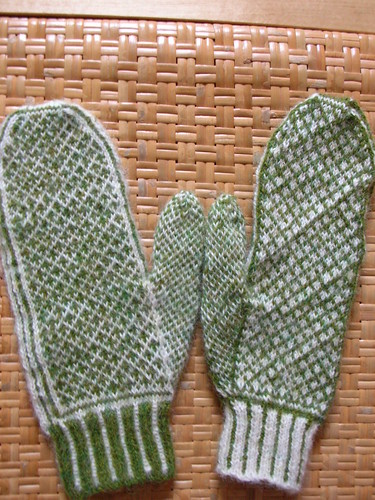
The blocked mitten looks a bit bigger, but usually knitted items shrink a bit after blocking. They are both the same size now.

After blocking:
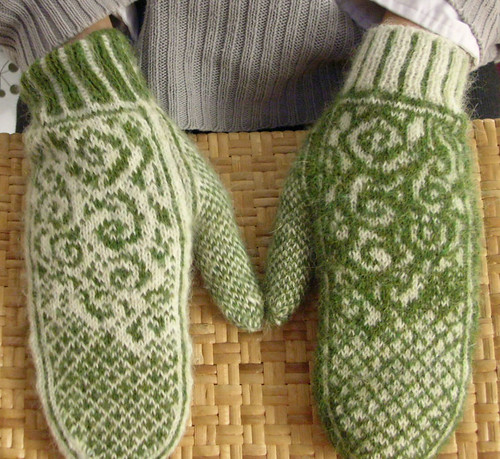
Well, blocking did resolve nearly everything, except for the very very very tight cuff and the very prominent green. It seems the tension on my left hand was a lot looser than when I knit the right mitten.
Cast-on:
For the cast-on I did a tubular cast-on. I followed Ysolda's instruction for a long-tail tubular cast-on, but I'm not sure if in the end I did the same thing as she did... She said that it differed from the Italian method where you can pull out the yarn, while here the strand that creates the stitches would alternate. Well, my impression was that there was only one strand that created the loops, in the front and in the back and I have been able to pull out the yarn. I also didn't start with a slip knot (I used the needle to pull at the yarn between my fingers and then started making the stitches).
Edit: I was researching how to do a better tubular cast-on for a different project and just found this post by TECHknitter. I thought I had been following Ysolda's instruction, but actually what I did resembles more what TECHknitter did.
Overall I like the mittens. Nice quick project and I learned a couple of new things.
Thursday, January 29, 2009
Finished: Anemoi Mittens
Eingestellt von projektleiterin um 6:17:00 PM 2 Kommentare
Labels: alpaca, Anemoi mittens, Eunny Jang, fair isle, mittens
Saturday, January 10, 2009
Mittens and a wrinkled dress
I finished the "Summersplash" yarn and I'm quite happy with it. I just don't know what to knit with it? Another Morning Surf Scarf? I don't have one, but maybe I can find something else that goes well with the yarn, too.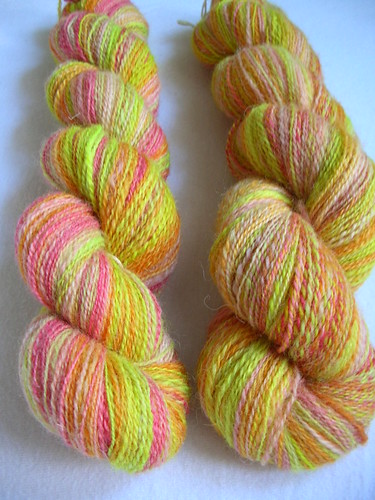
Currently I'm working on two items - fair isle mittens and a winter dress.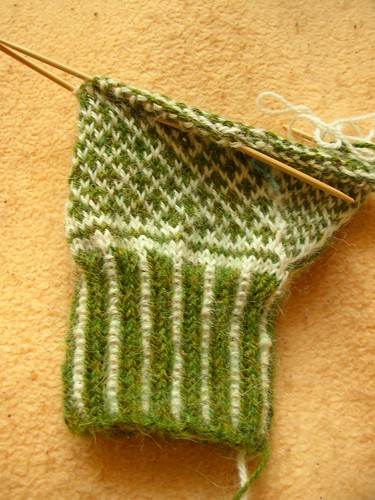
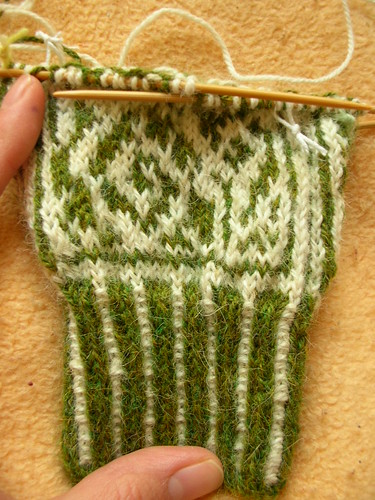
This is the first fair isle project I'm doing (apart from playing around with swatches here or there) and I'm quite pleased with my tension. The back part with the spirals puckers a bit, but the palm side is quite nice.
The dress might have been finished already if I wasn't ripping back so much. It's not difficult to knit, but I continue to make modifications, which I don't like, but I think I now found a good solution.
When I took the picture I realized how wrinkled the dress looks. I guess, when I knit something I don't really care too much how it looks. I stuff my projects in plastic bags and that shows. But washing and blocking will take all your tears away, so why bother.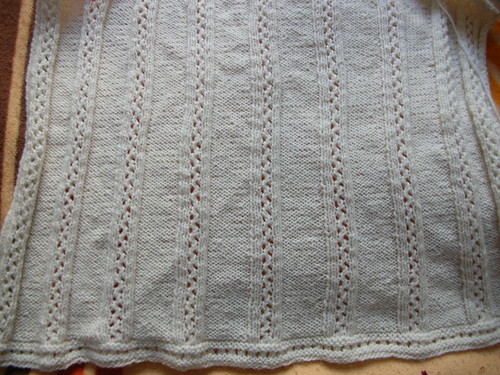
Eingestellt von projektleiterin um 2:20:00 PM 5 Kommentare
Labels: dress, Eunny Jang, fair isle, handspun, knitting, Rebecca, Rebecca no. 35
Monday, January 05, 2009
Finished Morning Surf Scarf and handspun yarn
Roving: 4.5 oz Domestic Spinning Wool
Colorway: Cyanotrichite
Dyer: TheFiberDenn.etsy.com
Pattern: Morning Surf Scarf by Jackie Erickson-Schweitzer (scroll down to click on the link, since she had this introductory text I didn't want to link directly to the pattern instructions)
Yarn: Handspun, see above
Color: Cyanotrichite
Price: ?
Amount: about 4.5 oz (about 130 g)
Needles: 3.75 mm (Takumi bamboo needles, they're really nice to knit with. I think they didn't make this annoying scraping noise that the other bamboo needles make. I stopped using them and mostly used wood needles, but resorted to these, because I don't have many 3.75 mm needles and the others were already stuck in some other project.)
Gauge: I think my yarn was in the 13 - 15 WPI (wraps per inch) range. For this she recommends to cast on 66 stitches
Dimensions: Good size for a scarf
Modifications: None, I was a willing slave to the instructions. The pattern is easy, but it's still not fun to knit. I wasn't able to get the pattern in the beginning for whatever reason and ended up tinking and ripping back (20 cm once!) more than I ever had for most of my other knitting projects.
The pattern is great for highlighting short color repeats, because with the dropped stitches you create bigger color patches than you would with a couple of knit stitches and this yarn was a bit problematic. Since I don't have much experience with spinning, the colors in the yarn blended and mixed a lot, creating a somewhat muddy look. If I had chosen a pattern with a lot of stockinette stitch it would have looked even more muddy, but with dropped stitches it turned out not perfect, but also not too ugly. Actually, everybody who saw it assured me that it looked fine. Yay! :)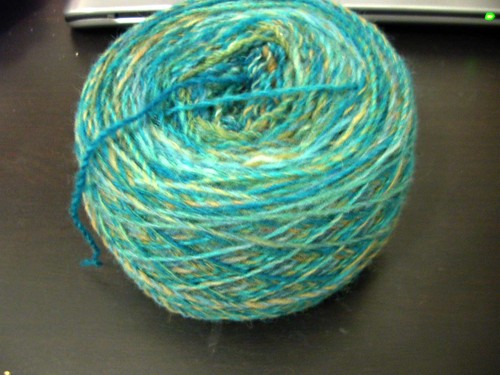
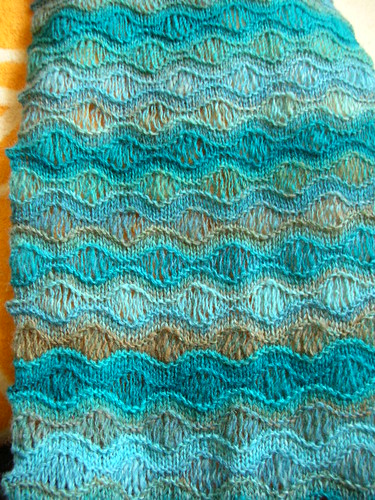
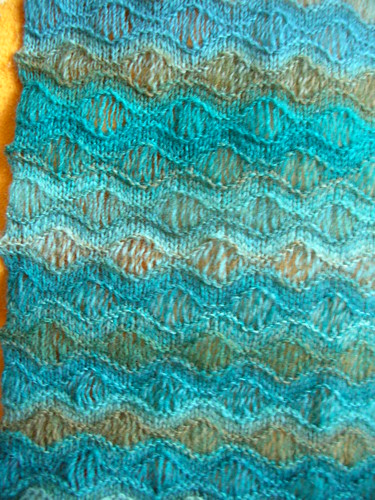
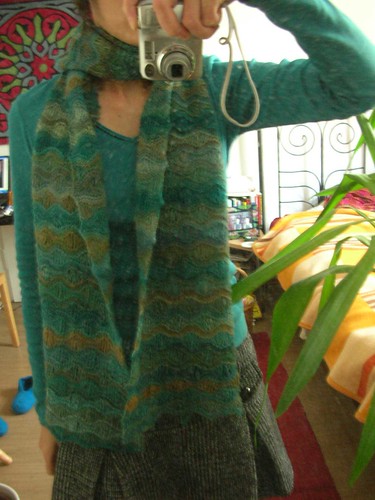
I think I need to clean my mirror... On the floor you can see the slippers made with Feltro that I mentioned here.
The scarf was a Christmas present for my mom and the light was usually not so good for taking pictures, so the pictures are not so great. The colors are also of the kind that are difficult to capture properly. And now I don't have the scarf anymore. I also made a pair of felted slippers for her and my aunt. And I finished another Paisley Shawl for my Grandma in a very nice green alpaca yarn from Drops (she will get it after Christmas though... :o).
Some laceweight yarn that I finished recently:
Singles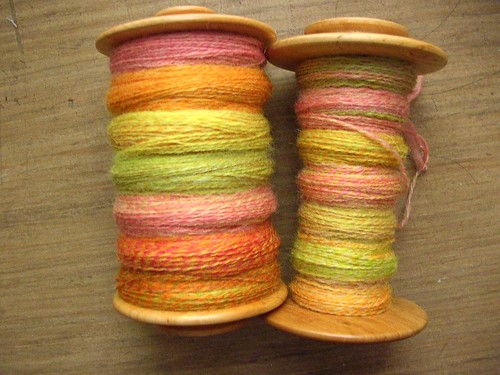
2-plyed laceweight
I'm pretty pleased with how the yarn turned out. Even when they colors got mixed up, the yarn still looked good (on the first full bobbin you can see the colors of the two plies still match, except for the yellow-red and green orange part on the lower part; the yarn on the second bobbin has mixed colors everywhere).
Roving: 4 oz kettle dyed BFL (Blue Faced Leicester)
Colorway: "Summersplash"
Dyer: marion.etsy.com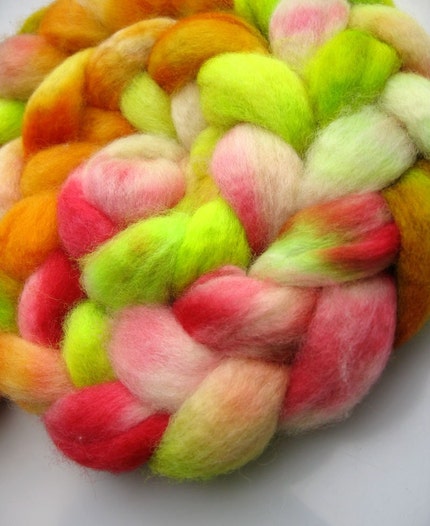
Eingestellt von projektleiterin um 4:08:00 PM 2 Kommentare
Labels: handspun, Jackie Erickson-Schweitzer, knitting, Morning Surf Scarf, spinning
Finished: felted slippers
Pattern: Felted DROPS slippers
Yarn: Anchor Wash + Filz-it, 100 % pure wool, 50 m/ 50 g, instructions say that it felts at 40 °C (didn't work for me though)
Color: red
Price: about € 3.50 a ball
Amount: 4
Needles: 8 mm
Gauge:
Dimensions: shoe size 37
Modifications:
Comments: Comfy, but ugly...
The yarn doesn't felt well at 40 °C in the washing machine, although that's the temperature in the instructions. I washed these twice at 40 °C and then twice at 60 °C and I'm *not* happy that the stitches are still visible. I stopped washing them with hot water, because the shoes seemed to be shrinking while the surface didn't change much.
I asked a shop assistant about a different felting yarn (Feltro by Lana Grossa, cheaper and softer than the Anchor, it was less than 3 Euros a ball) that I wanted to use for making slippers and she said that you should wash it at 60 °C even though the instructions also tell you to wash it at 40 °C. I knit another pair of shoes (http://lanagrossa.de/produkte/feltro.html Pretty nice. The heel needs some improvement - I would start with a couple of stitches less than recommended and then increase the number of stitches in 3-4 rows, so you will get a round heel - but the rest is ok, more or less. Three balls are enough for shoes the size 37.) and these looked right after washing them once at 60 °C.
I hated the DROPS pattern instructions (What? Huh??) and they're not very pretty. There's a couple of things I would do differently. I would knit the front part in the round and then do a three needle bind-off. All the sewing is just useless work.
I'm not really thrilled about the Anchor yarn. It's the most expensive felting yarn I have seen so far and it doesn't felt well, not for me at least. The range of colors is also small, maybe 7 colors, compared with Feltro, also mostly basic colors, but plus multivaried combinations, or the DROPS own-brand Eskimo (40 colors (!): http://www.wollkultur-shop.de/epages/15486368.sf/de_DE/?ObjectPath=/Shops/15486368/Categories/drops/Eskimo, I haven't ordered from this website yet though. I think Eskimo is not available in LYS. Of course, brick and mortar shops often carry less colors than online shops, there might be more colors available for the other brands, but they are the only ones I find in the local shops here.). I think Eskimo is not especially made for felting, but according to pictures I have seen it seems to felt well.
Before washing:
That's the wrong side out.
After washing: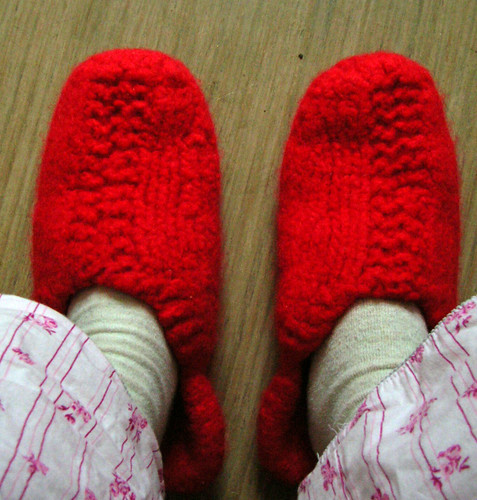
I think that's after 40 °C - 40 °C - 60 °C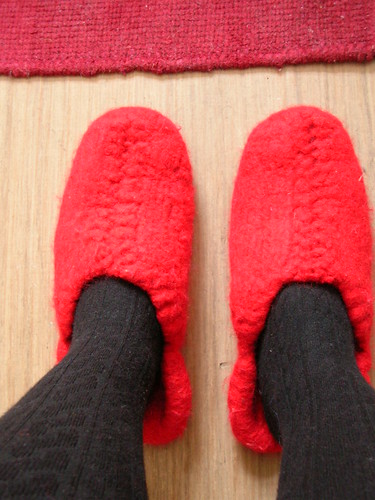
And that's after 40 °C - 40 °C - 60 °C - 60 °C
Ok, great. I just looked at the Ravelry project pages for this yarn and it seems that it does felt well (there's a very cute Christmas tree here: http://www.ravelry.com/projects/kaita/felted-trees. Just not for me! Maybe it's my washing machine? I actually felted the other shoes with my Mom's washing machine.
Eingestellt von projektleiterin um 3:19:00 PM 0 Kommentare







